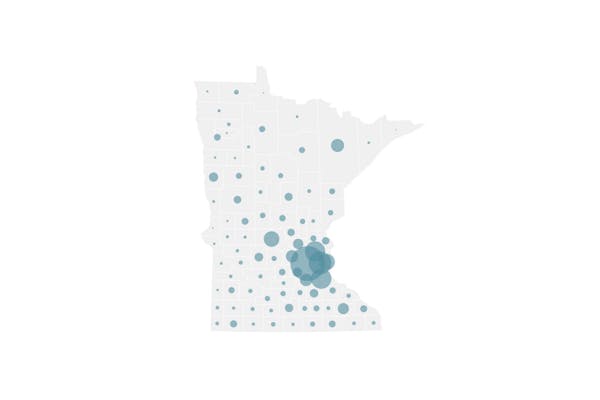Ten more people have died of COVID-19 in Minnesota and 1,537 new cases have been confirmed across the state, health officials reported Saturday.
After adjusting for corrections to earlier cases counts, Minnesota saw a net increase of 1,516 new coronavirus infections, according to the data released Saturday morning, on a volume of about 31,665 completed tests.
Both numbers are high compared with recent readings. Over the seven-day period ending Friday, the state was averaging about 1,135 new cases per day on a daily volume of about 24,176 tests.
The one-day tally for newly confirmed cases is the highest since the start of the pandemic, but comes on one of the highest-ever days in terms of testing volume.
Since the start of the pandemic, Minnesota has reported a total of 110,828 confirmed cases.
Residents of long-term care and assisted-living facilities accounted for five of the deaths newly announced by the Health Department. Statewide, 2,131 people have died from the disease, including 1,518 deaths in long-term care or assisted-living residents.
The state has been averaging about nine new deaths per day over the past week — somewhat higher than seven-day averages in recent months, but well below averages in May that exceeded 20 deaths per day.
COVID-19 is a viral respiratory illness caused by a new coronavirus that was found circulating late last year. Since the first case was reported in Minnesota in early March, hospital stays have been required in 8,302 cases.
People at greatest risk from COVID-19 include those 65 and older, residents of long-term care facilities and those with underlying medical conditions.
Health problems that increase COVID-19 risks range from lung disease and serious heart conditions to obesity and diabetes. People undergoing treatment for failing kidneys also run a greater risk, as do those with cancer and other conditions where treatments suppress immune systems.
Most patients with COVID-19 don't need to be hospitalized. The illness usually causes mild or moderate sickness; studies suggest that up to 45% of those who are infected won't have symptoms.
Numbers published Saturday morning cover the 24-hour period ending at 4 p.m. Friday.
This is a developing story. Check back for updates.
Christopher Snowbeck • 612-673-4744

Former diversity worker sues University of Minnesota after firing over swastika photo

As longtime Hutchinson, Litchfield papers close, 2 newspapers launch to take their place

In Grand Rapids, Itasca Pride is planning its first event, but there is already pushback
Mother charged with fentanyl overdose death of her 8-month-old boy in Roseville hotel room

